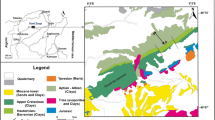The properties of one type of clay from the Orenburg Oblast are considered so as to determine its applications in industry. The mineral and chemical compositions as well as the dispersivity were determined, and an assessment was made of its degree of sintering. It was determined that the Orenburg Oblast clay is basic, with a high content of coloring oxides, and has medium dispersivity, it is moderately plastic, well-dried, and insensitive to desiccation. The mineral composition of the clay was determined. It was found that the main phases are kaolinite, smectite, illite, and quartz. Possible areas of application in the production of ceramic were identified. This clay can be used for the production of ceramic tiles of groups AII (b-1, b-2), AIII, BII (b), and BIII (GOST 13996–2019), ceramic bricks of grade M200 and higher (GOST 530–2012), and ceramic tiles (GOST 56688–2015).




Similar content being viewed by others
References
B. F. Gorbachev and E. V. Krasnikova, “Status of and possible ways to develop the raw material base of kaolins, refractory and high-melting-point clays in the Russian Federation,” Constr. Mater., No. 4 (2015); URL: https://cyberleninka.ru/article/n/sostoyanie-i-vozmozhnye-puti-razvitiyasyrievoy-bazy-kaolinovogneupornyh-i-tugoplavkih-glin-vrossiyskoy-federatsii (date of access: 02.15.2022).
N. F. Solodkii, A. S. Shamrikov, and V. M. Pogrebenkov, Mineral Resource Base of the Urals for the Ceramic, Refractory, and Glass Industry, Textbook [in Russian], Izd. TPU, Tomsk (2009).
G. Routschka and H. Wuthnow, Handbook of Refractory Materials: Design Properties Testings, Vulkan-Verlag GmbH, Essed (2012).
Y. Sawadogo, M. Sawadogo, M. Ouédraogo, et al., “Optimization of contents of three raw clay materials in formulation of a porcelain,” J. Mater. Sci. Chem. Eng., 10(1), 41 – 58 (2022); URL: https://doi.org/10.4236/msce.2022.101003.
J. F. Shackelford, R. H. Doremus (eds.), Ceramic and Glass Materials: Structure, Properties and Processing, Chapter 7. Clays, Springer Science+Business Media, LLC (2008), p. 111; https://doi.org/10.1007/978-0-387-73362-3.
C. R. Hubbard, E. H. Evans, and D. K. Smith, “The reference intensity ratio for computer simulated powder patterns,” J. Appl. Cryst., 169(9), 169 – 174 (1976).
N. Döbelin and R. Kleeberg, “Profex: a graphical user interface for the Rietveld refinement program BGMN,” J. Appl. Cryst., 48, 1573 – 1580 (2015).
Author information
Authors and Affiliations
Corresponding author
Additional information
Translated from Steklo i Keramika, No. 12, pp. 27 – 34, December, 2022.
Rights and permissions
Springer Nature or its licensor (e.g. a society or other partner) holds exclusive rights to this article under a publishing agreement with the author(s) or other rightsholder(s); author self-archiving of the accepted manuscript version of this article is solely governed by the terms of such publishing agreement and applicable law.
About this article
Cite this article
Glebova, A.A., Skovorodnikova, M.S., Pavlova, I.A. et al. Research on the Ceramic Properties of Orenburg Oblast Clay. Glass Ceram 79, 502–506 (2023). https://doi.org/10.1007/s10717-023-00540-6
Received:
Published:
Issue Date:
DOI: https://doi.org/10.1007/s10717-023-00540-6



